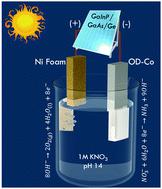当前位置:
X-MOL 学术
›
Energy Environ. Sci.
›
论文详情
Our official English website, www.x-mol.net, welcomes your feedback! (Note: you will need to create a separate account there.)
Solar-driven electrochemical synthesis of ammonia using nitrate with 11% solar-to-fuel efficiency at ambient conditions
Energy & Environmental Science ( IF 32.5 ) Pub Date : 2021-09-07 , DOI: 10.1039/d1ee01879e Nishithan C. Kani 1 , Joseph A. Gauthier 2, 3, 4 , Aditya Prajapati 1 , Jane Edgington 5 , Isha Bordawekar 6 , Windom Shields 7 , Mitchell Shields 7 , Linsey C. Seitz 5 , Aayush R. Singh 8 , Meenesh R. Singh 1
Energy & Environmental Science ( IF 32.5 ) Pub Date : 2021-09-07 , DOI: 10.1039/d1ee01879e Nishithan C. Kani 1 , Joseph A. Gauthier 2, 3, 4 , Aditya Prajapati 1 , Jane Edgington 5 , Isha Bordawekar 6 , Windom Shields 7 , Mitchell Shields 7 , Linsey C. Seitz 5 , Aayush R. Singh 8 , Meenesh R. Singh 1
Affiliation

|
Ammonia is an essential commodity chemical used in the manufacture of fertilizers, pharmaceuticals, ammunition, and plastics, and is a promising alternative fuel source and carrier. Today most ammonia is manufactured by the century-old Haber–Bosch process, which accounts for 1–2% of worldwide energy production and a substantial fraction of global greenhouse gas emissions. Solar-driven electrochemical synthesis of ammonia using nitrates presents a sustainable pathway to produce renewable fuels utilizing wastewater. Previous efforts in solar-driven electrosynthesis of ammonia have been seriously affected by lower specific activity (<10 mA cm−2) of electrochemical nitrate reduction reaction (NiRR) and thereby lower solar-to-fuel (STF) efficiency (<1%). Here, we show oxide-derived Co as an efficient NiRR catalyst with the highest specific activity (∼14.56 mA cm−2 at −0.8 V vs. RHE) and selectivity. The oxide-derived Co offers a maximum faradaic efficiency of 92.37 ± 6.7% and ammonia current density of 565.26 mA cm−2 at −0.8 V vs. RHE. Integrating this catalyst in a PV-electrolyzer cell yields an unprecedented STF efficiency of 11% for ammonia, which is an order of magnitude higher than state-of-the-art systems.
中文翻译:

使用硝酸盐的太阳能驱动的氨电化学合成,在环境条件下具有 11% 的太阳能燃料效率
氨是一种用于制造肥料、药物、弹药和塑料的基本商品化学品,是一种很有前途的替代燃料来源和载体。今天,大多数氨是由具有百年历史的 Haber-Bosch 工艺制造的,该工艺占全球能源生产的 1-2% 和全球温室气体排放的很大一部分。使用硝酸盐太阳能驱动的氨电化学合成提供了一种利用废水生产可再生燃料的可持续途径。先前在太阳能驱动的氨电合成方面的努力受到较低比活度(<10 mA cm -2) 电化学硝酸盐还原反应 (NiRR),从而降低太阳能燃料 (STF) 效率 (<1%)。在这里,我们展示了氧化物衍生的 Co 作为一种高效的 NiRR 催化剂,具有最高的比活性(~14.56 mA cm -2 at -0.8 V vs. RHE)和选择性。氧化物衍生的 Co在 -0.8 V vs. RHE 下提供 92.37 ± 6.7% 的最大法拉第效率和 565.26 mA cm -2 的氨电流密度。将这种催化剂集成到光伏电解槽中,氨的 STF 效率达到了前所未有的 11%,比最先进的系统高出一个数量级。
更新日期:2021-09-07
中文翻译:

使用硝酸盐的太阳能驱动的氨电化学合成,在环境条件下具有 11% 的太阳能燃料效率
氨是一种用于制造肥料、药物、弹药和塑料的基本商品化学品,是一种很有前途的替代燃料来源和载体。今天,大多数氨是由具有百年历史的 Haber-Bosch 工艺制造的,该工艺占全球能源生产的 1-2% 和全球温室气体排放的很大一部分。使用硝酸盐太阳能驱动的氨电化学合成提供了一种利用废水生产可再生燃料的可持续途径。先前在太阳能驱动的氨电合成方面的努力受到较低比活度(<10 mA cm -2) 电化学硝酸盐还原反应 (NiRR),从而降低太阳能燃料 (STF) 效率 (<1%)。在这里,我们展示了氧化物衍生的 Co 作为一种高效的 NiRR 催化剂,具有最高的比活性(~14.56 mA cm -2 at -0.8 V vs. RHE)和选择性。氧化物衍生的 Co在 -0.8 V vs. RHE 下提供 92.37 ± 6.7% 的最大法拉第效率和 565.26 mA cm -2 的氨电流密度。将这种催化剂集成到光伏电解槽中,氨的 STF 效率达到了前所未有的 11%,比最先进的系统高出一个数量级。



























 京公网安备 11010802027423号
京公网安备 11010802027423号